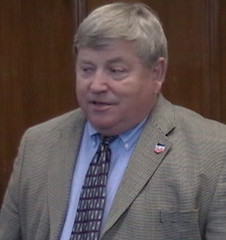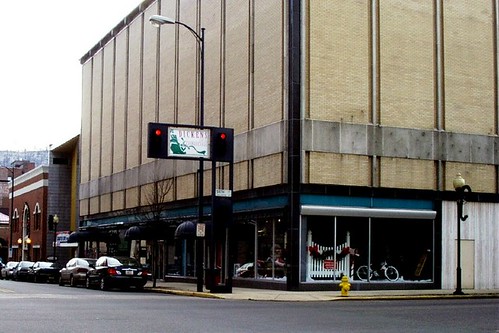| Ohio's 88 counties color coded according to health rankings |
Scioto County and the “Portsmouth Boys”
The health rankings which the Health Policy Institute of Ohio, with the support of the Robert Wood Johnson Foundation, makes about Ohio's 88 counties, on the basis of available statistics (click here), is probably about as comprehensive an evaluation of an Ohio county’s overall health, or quality of life, as we can get. Ohio’s health rankings, include a lot of categories. It is based on statistics regarding, among other things—to list them alphabetically—air quality, alcoholism, diabetes, drug use, exercise, health insurance, junk food, level of education, obesity, poverty, premature death, quality of drinking water, recreational facilities, sexually transmitted diseases, single parent families, smoking, teen pregnancy, unemployment, vehicular deaths, and violent crime. If it is not complete, it covers a whole lot of things, because a whole lot of things affect the health of a county.
Which Ohio county is first in the most recent (2013) Health Policy Institute health rankings? Gauega, up in the northeast corner of the state. (Just as Scioto is a native American word, meaning deer, Gauega is also a native American word, meaning raccoon.) I had never heard of Gauega until I saw it ranked as the healthiest county in Ohio. In 2008, Forbes magazine rated Gauega the fourth best county in which to raise a family, fourth not in Ohio but in all of America.
Which Ohio county is at the bottom of the most recent health rankings? If you haven’t already heard, and you’re from Scioto County, you might be able to guess which county is 88th. Yes, Scioto County. When all the categories are averaged out, Scioto is at the bottom. Why? No one factor could account for why. There are lots of factors—economic, cultural, ethnographic, political— some of which go way back in time.
Scioto County’s economic problems are profound, and the chronically depressed economy may be the most important reason why it is at the bottom of the health rankings. After the Second World War, the development of the so-called global economy led to the wholesale migration of American industries abroad, where the cost of labor and raw materials were much cheaper. The global economy was the death knell for the industries in south-central Ohio, particularly for the steel and shoe industries of Scioto Country. But the cultural, ethnographic, and political factors worsened the county’s economic problems.
From my observations of almost a quarter century residency, the culture in southern Ohio, usually called Appalachian, is exclusionary rather than inclusionary, collusive rather than competitive. The people tend to be independent but not especially industrious, to be creative and colorful but not particularly enterprising. Clayton Johnson was reportedly overheard to say the locals never learned how to use alarm clocks. The culture of south-central Ohio tends to keep everything in the family, using the term family in its broadest sense. That culture is distrustful of outsiders, to new ideas and methods. It is, in the language of anthropology, endogamous, which is the tendency to marry within the group, as opposed to exogamous, the tendency to marry outside the group. But “married,” sociologically speaking, means keeping things within the group, not just the family, and not just women but opportunities and advantages, and especially in the last half century, the money and pork government provides to the poor and unemployed of Appalachia. If Grapes of Wrath dramatizes the predicament of the Oakies in the Great Depression, Taps for Private Tussie (click here) does the same for Appalachians in the early 1940s, during the Second World War.
Portsmouth Boys
The “Portsmouth Boy,” to borrow a term from Frank Lewis, is at the apex of the endogamous, if not incestuous, culture of Scioto County. Economically and politically, rich, gray-haired Portsmouth Boys control Portsmouth, the county seat. Because of chronic depression, Scioto County has been on the dole, directly and indirectly, for about a half century. The Portsmouth Boys decide for what and to whom government money is distributed. The Marting Foundation is the most influential and notorious of the local private organizations distributing government money.
The Scioto County Welcome Center is the unofficial city hall created by and for the Portsmouth Boys with government money. I liken it to the social clubs that the Mafia (who play poker instead of bingo) created in lower Manhattan (where I once lived). The social clubs were fronts for rackets and for the laundering of money derived from those rackets. The Scioto County Welcome Center laundered government money. Bob Huff was chief executive officer of the Welcome Center, but he was not a Portsmouth Boy and he ended up being the fall guy who was blamed when the racketeering and the laundering of government money came to light.
On the day the new Grant Bridge was opened in October 2006 (click here), after taking longer to build than the Golden Gate Bridge, the cut-up Steve Hayes reported on WNXT that Bob Huff was outside giving passing motorists the finger (a photo shows Huff waving, not giving the bird, as if he was taking credit for the bridge). Bob Huff, not a Portsmouth Boy, was the one who ended up getting the finger after which he got out of town, pending prosecution, assuming that ever happens.
 |
| Bob Huff waving, before he got the finger |
“He Who Pisses”
Instead of Scioto, an Indian word meaning deer, a more appropriate native name for the county might be, Squunck, a native word for skunk. Squunckmeans, literally “he who pisses,” which is what the former redneck mayor Jim Kalb said I was not worthy of—not worthy of being pissed on. Our current black, philandering, unelected mayor, the Rev. David Malone, is not much better. Both of them in their parasitical careers, have declared bankruptcy, a fact that Frank Lewis, of the Daily (except Mondays) Times (PDT), does not mention. Kalb and Malone are just the kind of unsuccessful Portsmouth Boys, the kind of moral bankrupts, that the rich Portsmouth Boys help get elected to public office. Kalb and Malone, the dregs of the Portsmouth Boys, found in public office a refuge from the shame and failure of their insignificant lives, failure being the unpardonable sin of American life. Kalb would have long ago been fired from Kroger’s, where he was a lowly grocery clerk, if it had not been for the protection provided by the Teamsters, the union founded by a former Cincinnati Kroger employee, Jimmy Hoffa. Kalb’s second wife at one time got a restraining order against him. If only we could take out restraining orders against the rich Portsmouth Boys. That might at least begin to improve the health, the quality of life, in Scioto County.
The impassioned Austin Leedom’s has denounced the most recent general manager of the PDT, Mike Messerly, as a tool of the Portsmouth Boys. Since he is not a Portsmouth Boy himself, Messerly’s job is no more secure than was that of any of his many predecessors. Although it is only a shadow of what it once was, the local media, with Steve Hayes blatantly at WNXT and Frank Lewis more insinuatingly at PDT, have been instrumental in helping the rich Portsmouth Boys remain in control of the county and city. The consequence of the rich Portsmouth Boys remaining in control is that Scioto County will remain 88th, at the bottom of Ohio’s health rankings and we will continue to live in Skunk Holler. The county map above, with the color coding, shows that most of the bottom tier of the counties are concentrated in south-central Ohio, with Scioto (abbreviated SC) at the bottom of the map and in the rankings (see below), suggesting what part of the human anatomy it is analogous to. In Scioto County we are married not to the Mob but to the Portsmouth Boys.
| Ohio County Health Ranking |



































